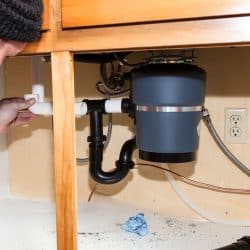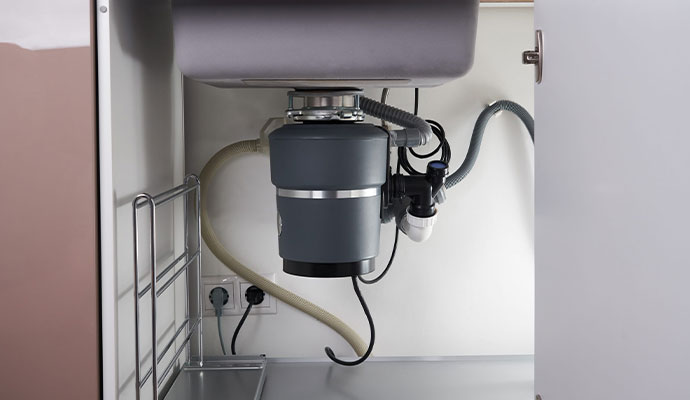Top Tips for Fixing a Leaking Waste Disposal Unit
Top Tips for Fixing a Leaking Waste Disposal Unit
Blog Article
Everybody may have their unique views involving The Handy Guide To Fixing Your Garbage Disposal Leaking.

Waste disposal unit are essential kitchen area home appliances that aid in getting rid of food waste successfully. Nonetheless, a dripping garbage disposal can be an aggravating and untidy issue to take care of. The good news is, several leakages can be dealt with conveniently with a couple of basic actions. In this post, we will talk about how to fix a dripping waste disposal unit successfully.
Introduction
Garbage disposals are mounted under cooking area sinks and are created to shred food waste into smaller sized items, allowing it to pass through the pipes system easily. While these tools are normally dependable, leakages can occur with time because of wear and tear, loose connections, or damages to the system.
Step-by-Step Guide to Dealing With a Dripping Waste Disposal Unit
Turn Off the Power
Before trying any fixings, guarantee that the power to the waste disposal unit device is switched off to prevent the risk of electric shock.
Locate the Leak
Determine the precise place of the leak and identify the cause
Tighten Connections
Use a wrench to tighten up any kind of loosened links between the disposal unit and the pipes system.
Change Seals or Gaskets
If the leak is due to used seals or gaskets, get rid of the old elements and replace them with brand-new ones.
Patching Fractures or Holes
For splits or openings in the disposal unit, usage epoxy or an appropriate patching material to secure the damaged area.
Recognizing the Resource of the Leak
Prior to trying to deal with a leaking waste disposal unit, it is vital to identify the source of the leak. This can normally be done via visual inspection or by conducting easy tests.
Visual Inspection
Inspect the garbage disposal unit carefully for any kind of indicators of water leak. Pay close attention to locations around seals, gaskets, and connection points.
Examining for Leakages
One method to check for leakages is by running water via the disposal system and checking for any noticeable indications of leak.
Typical Reasons For Leakages in Rubbish Disposals
Worn Seals and Gaskets
Seals and gaskets play an important role in stopping water from leaking out of the garbage disposal. Over time, these elements can wear away, resulting in leakages around the disposal device.
Loose Connections
The connections in between the garbage disposal and the plumbing system can end up being loosened in time, creating water to leakage out throughout procedure.
Fractures or Holes in the Disposal Unit
Physical damage to the waste disposal unit, such as splits or openings in the housing, can also cause leakages.
Tools and Materials Needed for Fixing a Dripping Waste Disposal Unit
Before starting the fixing process, gather the essential tools and materials, consisting of a screwdriver, adjustable wrench, plumber's putty, substitute seals or gaskets, and epoxy or patching material for fixing cracks or openings.
Evaluating the Waste Disposal Unit After Repair Work
As soon as the repair work is full, evaluate the waste disposal unit by running water through it to make sure that the leakage has been solved.
Preventive Upkeep Tips to Avoid Future Leaks
To stop future leaks, it is necessary to do normal maintenance on your garbage disposal. This includes maintaining it tidy, staying clear of putting non-food items or difficult items down the disposal, and regularly looking for leakages or various other concerns.
Verdict
Finally, fixing a leaking garbage disposal is a relatively straightforward procedure that can be finished with fundamental devices and products. By following the actions described in this article and exercising preventative maintenance, you can maintain your garbage disposal in good working condition and stay clear of costly repair services in the future.
What to Do About a Leaking Garbage Disposal
A leaking garbage disposal often goes unnoticed until you confront a sopping cabinet, a foul-smelling puddle, or an audible drip-drip-drip from the unit. The fix can be frustrating, too, because the leak can stem from a number of components in the system. Fortunately, with a little sleuthing, you can zero in on the leak and—depending on the exact location—stop the icky oozing and repair the component that caused it. Worst case scenario, if it turns out that the garbage disposal must be replaced, installing a new one is a reasonable do-it-yourself task for those with basic plumbing skills. Read on to keep the cash you’d otherwise hand over to a pro.
Prepare to find the leak
Prior to testing the garbage disposal for leaks, unplug it at the wall outlet and turn off the power from the breaker box to prevent electrical shock. Then insert a watertight sink stopper into your sink drain and wipe the unit dry with a clean cloth. In any handy container, mix a few drops of food coloring into a few cups of water, and pour the dyed water onto the sink stopper to help you locate the leak.
Investigate the source
the top, where the disposal meets the sink drain the side, where the dishwasher hose or main drain pipe connects to the disposal or the bottom of the unit Inspect each of these locations while gliding a light-colored rag over the unit; the dyed water will readily show on the rag and reveal the location of the leak. If a leak isn’t immediately apparent, remove the sink stopper and pour a few more cups of dyed water down the sink drain, then check for leaks again. Leaks near the top of the unit are more likely to show themselves while the sink is plugged, while side and bottom leaks are more noticeable while the sink is unplugged.
The metal sink flange that sits directly inside the sink drain is typically sealed around the top with plumber’s putty (a clay-like sealant) and then secured from under the sink with bolts. If the plumber’s putty deteriorates, or the bolts loosen, the flange can no longer form a watertight seal between the sink drain and the disposal—which could cause a leak at the top of the unit.
To reseal the leaky flange, you must first detach the garbage disposal. Start by loosening the screws securing the main drain pipe to the disposal, then loosen the screws in the metal clamp securing the dishwasher hose to the disposal and detach the drain pipe and dishwasher hose from the disposal. Loosen the screws in the mounting ring that connects the disposal to the metal mounting assembly beneath the sink, then pull down the disposal and carefully set it on a clean, dry surface. Loosen the bolts in the mounting assembly with a wrench, then pull down the mounting assembly and set it near the disposal.

I was shown that write-up on The Handy Guide To Fixing Your Garbage Disposal Leaking through a good friend on another blog. Liked our post? Please share it. Help another person check it out. I thank you for reading our article about Why Is .
Call Today Report this page